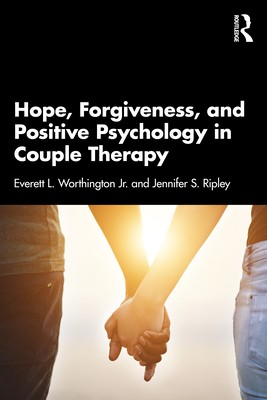
- We will send in 10–14 business days.
- Author: Everett Worthington
- Publisher: Routledge
- ISBN-10: 0367443848
- ISBN-13: 9780367443849
- Format: 15.2 x 22.9 x 1.8 cm, minkšti viršeliai
- Language: English
- SAVE -10% with code: EXTRA
Hope, Forgiveness, and Positive Psychology in Couple Therapy (e-book) (used book) | bookbook.eu
Reviews
Description
This practical book provides a guide for therapists who want to be more effective in couple therapy. With 125 boxed interventions explained within a patient-friendly framework emphasizing hope and a strategy for change, this resource can expand the flexibility of any therapist regardless of theoretical approach.
Providing a theoretical framework that sees interventions as aimed at strengthening couples' emotional bonds, Hope, Forgiveness and Positive Psychology in Couple Therapy aims to deliver a practical strategy to build love, enhance work, and promote partners' faith in each other and in therapy. Interventions are discussed within several parts:
- Conducting the initial intake, assessment, and feedback,
- Coaching conflict resolution and better communication
- Promoting intimate bonding
- Helping couples close the injustice gap in several ways, one of which is forgiving,
- Helping couples reconcile
- Building trust, and
- Facilitating termination.
These interventions fit with all major couple therapies that embrace a patient-responsive approach. Most of the published research on the hope-focused couple approach is on treating secular couples. However, two previous books aimed at therapists who must treat religiously committed couples have been widely used in couple-counselling courses, clinics, and clinicians' private collections primarily because the interventions have been imminently useful. In the present book, aimed at general secular practice, there are almost 100 new interventions to enrich clinical practice with couples.
EXTRA 10 % discount with code: EXTRA
The promotion ends in 23d.04:47:41
The discount code is valid when purchasing from 10 €. Discounts do not stack.
- Author: Everett Worthington
- Publisher: Routledge
- ISBN-10: 0367443848
- ISBN-13: 9780367443849
- Format: 15.2 x 22.9 x 1.8 cm, minkšti viršeliai
- Language: English English
This practical book provides a guide for therapists who want to be more effective in couple therapy. With 125 boxed interventions explained within a patient-friendly framework emphasizing hope and a strategy for change, this resource can expand the flexibility of any therapist regardless of theoretical approach.
Providing a theoretical framework that sees interventions as aimed at strengthening couples' emotional bonds, Hope, Forgiveness and Positive Psychology in Couple Therapy aims to deliver a practical strategy to build love, enhance work, and promote partners' faith in each other and in therapy. Interventions are discussed within several parts:
- Conducting the initial intake, assessment, and feedback,
- Coaching conflict resolution and better communication
- Promoting intimate bonding
- Helping couples close the injustice gap in several ways, one of which is forgiving,
- Helping couples reconcile
- Building trust, and
- Facilitating termination.
These interventions fit with all major couple therapies that embrace a patient-responsive approach. Most of the published research on the hope-focused couple approach is on treating secular couples. However, two previous books aimed at therapists who must treat religiously committed couples have been widely used in couple-counselling courses, clinics, and clinicians' private collections primarily because the interventions have been imminently useful. In the present book, aimed at general secular practice, there are almost 100 new interventions to enrich clinical practice with couples.


Reviews